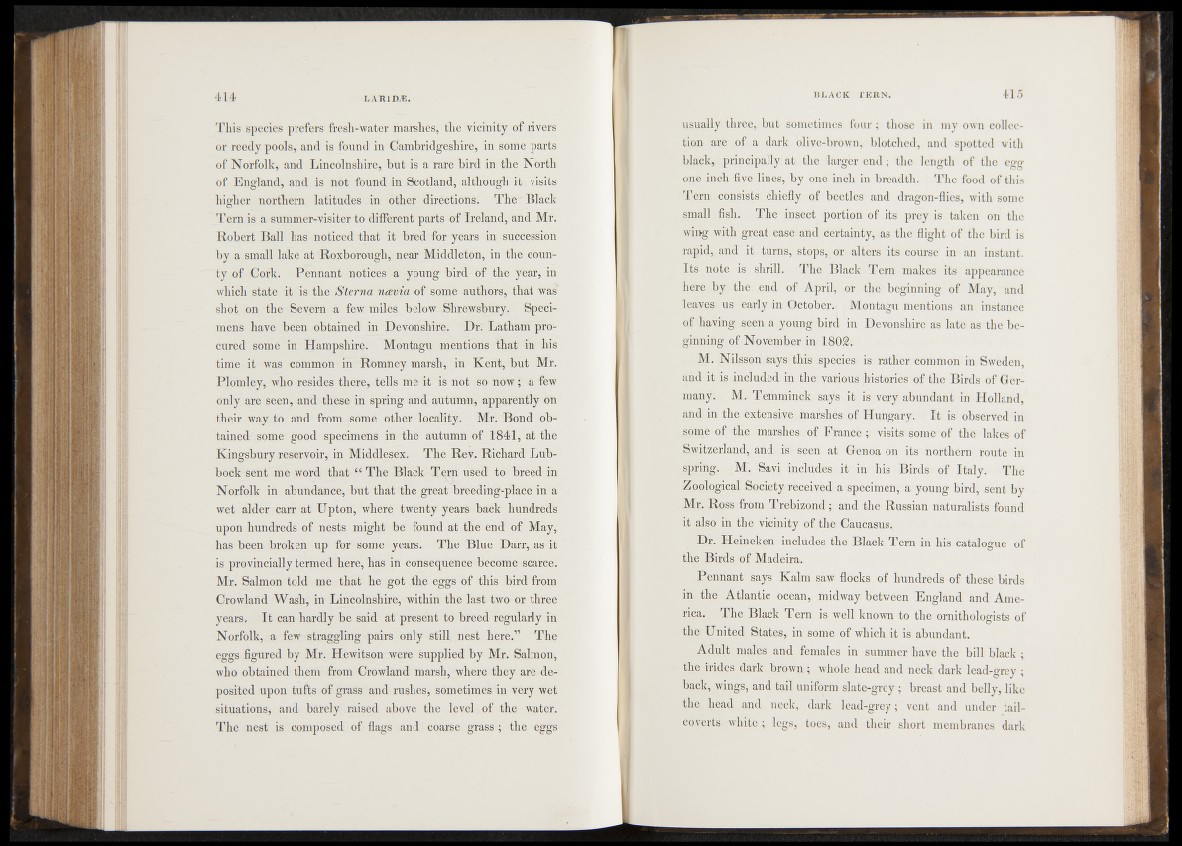
This species prefers fresh-water marshes, the vicinity of rivers
or reedy pools, and is found in Cambridgeshire, in some parts
of Norfolk, and Lincolnshire, but is a rare bird in the1 North
of England, and is not found in Scotland, although it-» visits
higher , northern latitudes in other directions.' The*' Black
Tern.is a summerwdsiter to different parts of Ireland, and Mr.
Robert Ball has -noticed that it bred lor years in succession"1'
by a small lake at Roxborbugh, near MiddlejjtpW, in the county
of Cotfe Pennant notices a young bird Of the year, in
which state it is the Sterna naevia of some authors* that was
shot on the Severn a few miles below-Shrewsbury. Specimens
have been ^obtained in Deyod^Mire. Dr'; Latham procured'some
in Hampshire. Montagu mentions that in his
time it was common in Romhëy marsh, in Kent* but Mr.
Plomley, who resides there, fells me it ff¬ so now; a few
only are seen, and these in spring and autumn, apparently on
their way to and from some other locality^ Mr. Bond obtained?
some' good specimens in the autumn of 1841, at the
Kingsbury reservoir, in Middlesex -- The Rev. Richard Lubbock
senf me word that (i The Black Tern used to breed in
Norfolk ih abundance, but that the great breeding-place in a
wet alder carr at Upton, where twenty years back hundreds
upon hundreds of. nésts might be' found at the end of May,
has been broken up for some years. The- Bine Darr, as it
is provincially termed here, has in consequence become scarce*/
Mr. Salmon told me that he got the eggs of this bird from
Crowland Wash, in Lincolnshire, within the last two or three
years. I t can hardly be said at present to breed regularly in
Norfolk, a few straggling pairs ofily sfcilL jnest" here.’’ The
.eggs figured by Mr. Hëwitson were supplied by Mr. Salmon,
who obtained them from Crowland marsh, where they are. deposited
upon tufts of grass an d rushes*? sometimes in very wet
situations, and barely raised above the level óf the water.
The nest is composed of flags and coarse grass; the eggs
usually three, but sometimes four; those in my own collection
arè^of a dark -olive-brown, blotched, and spotted with
bl^k,.; principally af the larger en d ; the length of the egg
one inch five lines, by one inch in breadth. The food of this
Tern.|#nsists chiefly ^"beetles and dragon-flies, with some
small I fish. The insect, portion of its prey is taken on the
wing with great ease and certainty, as the flight of the bird is
rapid,, and it-.’turns, stopsg.dr- alters its course' in an instant.
Its npfc e?is shrill. The Black Terri'makes its appearance
here by th ^ e n d of -April, or the beginning of May, and
leajvejsi* us^ïëiriy in.DctoberU Montagu mentions an instance
of having» -seen a.young/biid in Devonshire'as late as the beginning
of »November in 1802.
M. Nilsson .saysirthis» .species», is rather Comm on in Sweden,
and i^i'included/in the various histories of the Birds of Ger-
-m^nyk'dM. T,emminck says it.is^veiyiiabundant in Holland/
and in the extensiyè m aM ^ q f Hungary. It is observed in
,§omè of the marshes,of J|ian'cfe^-visits some of the lakes of
S\^prfand, a n d ^ e ^ i i . at Genoa on its northern route in
spring.,. M". Savi includes« it in his Birds of Italy. The
Zoological Soeietyf-^êeeiyéd ^ specimen, a young bird, sent by
M^RpssffrtmTrebizond; and the Russian naturalists found
it also in the vicinity of,the Caucasus.
Dr. Heineken insides- the Black Tern in his catalogue of
the Birds of Madeira.
Pennant saystfedm saw flocks of hundreds of these birds
in the Atlantic bce&n, midway; between England and America.
The Black Tern is well known to the ornithologists of
the* United States, in some of which it is abundant.
Adult males and females in summer have the bill black ;
thef bides dark brown; whole head and neck dark lead-grey ;
back, wings, and tail uniform slate-grey; breast afad belly, like
the head and neck, dark lead-grey; vent and under tail-
coverts white; legs, toes, and their short membranes dark